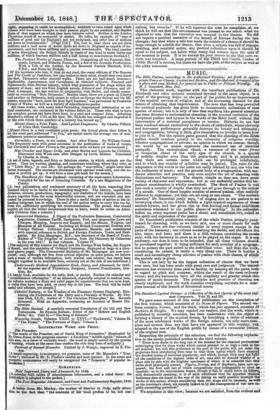M USIC.
The Bible Psalms, according to the Authorized Version; set forth to appro- priate Tunes or Chants, Ancient and Modern, and Divided and Arranged after a_plain and easy Method, for general use in Public or Private Worshap. By H. J. Gauntlett, Mus. Doc.
This elaborate work, together with the excellent publications of Dr. Rimbault and other eminent musicians devoted to the same object, is a proof of the growing desire on the part of the public for an improvement of the musical services of religion, and of the increasing demand for the means of obtaining that improvement. The love that has long prevailed for metrical psalmody has given birth to innumerable collections of that species of music; but it is only of late that anything like general attention has been directed to ecclesiastical chanting, or the musical recitation of the Scriptural psalms and hymns in the words of the Bible itself, without the intervention of a metrical paraphrase or version. Hitherto its use has been confined almost exclusively to the choirs of cathedrals, whose slovenly and irreverent performance generally destroys its beauty and solemnity; and congregations, valuing it little, give themselves no trouble to learn how to join in it. But the opinion gains ground that the chanting of the Bible psalms would conduce greatly to the solemnity of religious worship, whether congregational or private; an opinion in which we concur, though we would by no means supersede the occasional use of metrical psalmody. The ecclesiastical chant, a remnant-of the canto fermi or Gregorian chant of the early ages of the church, is a species of melody simpler even than the psalm-tune, and is so constructed that there are certain notes which can be prolonged indefinitely, and to which any number of syllables may be joined. The rules for the adaptation of the words to the notes are easily learned by any, ope who has the rudiments of music; and the general body of a congregation, with mo4 derate attention and practice, may soon acquire the art of chanting with", distinctness and harmony. The chants, simple as they are, have great variety of character and expression; but in our cathedral service this im- portant consideration is wholly overlooked. The- Book of Psalms is cut'', into such a number of lengths that they are all gone through in the course of a month. One of these lengths consists of several psalms, often entirely different in expression; yet they are all sang to one chant. " The modem ' practice," Dr. Gauntlett justly says, "of singing five or six psalms to an unvarying chant, is one which forbids, a right musical expression of thews ancient hymns, and has given rise to that .hurried. and formal exhibitionita sometimes witnessed in our public places of worship." In the collection/1 before us, every separate psalm has a chant, and sometimes two, suited to the spirit and expression of the poetry.
Dr. Gauntlett's publication consists of the whole Psalter, properly punc- tuated for chanting, with, as we have said, one or more chants for each" psalin. There are four volumes, similar in every respect except in the parts of the harmony; one volume containing the treble, and the others the alto, tenor, and bass; and there is a fifth volume, containing the musks T only, with the harmony in score so as to be played on the organ. It is noS03 necessary, nor does it seem to be intended, that all these volumes shoulduz be purchased together; it being sufficient for each member of a congregas a tion to possess the part suited to the individual voice: and thus the work,3 considering its extent, is really a very cheap one. There is besides a small and exceedingly cheap selection of psalms with their chants, Of which'',
or the melody only is given.
This is not only by far the largest collection of chants that we have' a ever seen, but has been made with great care and judgment. The utmostris attention has evidently been paid to facility, by keeping all the parts, both att in regard to pitch and compass, within the reach of the most ordinaryi,^± voices; and the harmonies have all the simplicity and gravity which this. species of music demands. The principles and practice of chanting are- clearly explained; and the work contains everything requisite for a com-
plete manual of this branch of devotional music. ssi


























 Previous page
Previous page